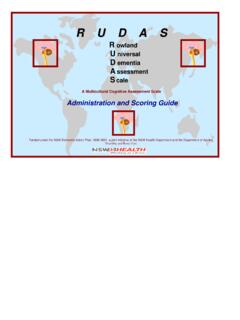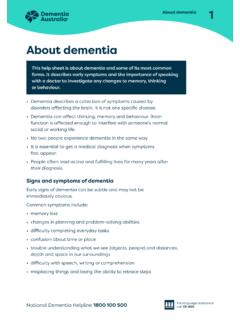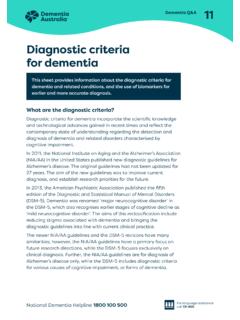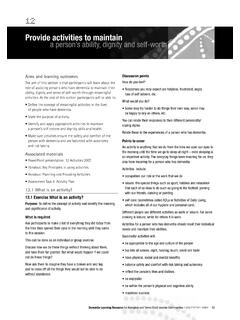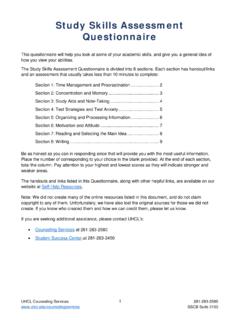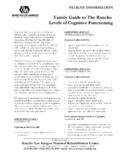Transcription of Ways of communicating with a person who has ... - Dementia
1 Aims and learning outcomesThis section builds on Section 8 Communication Skills . It explores: how Dementia can change the way a person communicates, and strategies that help effective the end of this training session participants will be able to: recognise Dementia related communication changes recognise the two way process of communication with people who have Dementia apply effective strategies in communicating with people who have materials PowerPoint presentation: 11 Communication 2007. Exercise: Whispers cards (preparation required). Exercise: Communication Handout: communicating with a person with Dementia . Assessment Task 6: The Need for Good Communication. Assessment Task 7: Maintaining note: Link this section with 8 Communication Skills and take account of specific cultural mores about person with Dementia is unique and there are many forms of Dementia that affect the brain in different ways .
2 Communication changes that occur as a result of Dementia will vary from individual to to earlier section on Communication changesSome changes you may notice in the person with Dementia include: difficulty in finding a word. A related word may be used instead of one that they cannot remember reduced vocabulary they may speak fluently, but not make sense they may not be able to understand what you are saying or only be able to grasp part of it reverting to a first language writing and reading skill may also deteriorate they may lose appropriate social or cultural communication processes they may interrupt or ignore a speaker or not respond when spoken to they may have difficulty expressing emotions that while some people may have difficulty expressing themselves, they may be able to understand everything that is said to of communication changes include.
3 Progressive memory loss difficulty processing information and difficulty understanding speech centre of the brain not working properly problems with hearing, poor sight, teeth/dentures damage to the brain causing changes such as repetition of statements or can also be a reaction to: confusion, fatigue, fear or anxiety not remembering new places, situations, changes in routine or living in an unfamiliar environment making mistakes, fear of making mistakes, or not meeting the expectations of Exercise: WhispersFacilitator noteYou will need to prepare cards with phrases prior to this exercise. Examples are provided but you may want to select others. One phrase is simple and one is long and complex. The second one will provide rich opportunity to discuss communication : To experience the consequences of simple and complex is requiredHave two cards prepared 46 Dementia Learning Resource for Aboriginal and Torres Strait Islander Communities Facilitators Guide 11 ways of communicatingwith a person who has Dementia Card 1: A simple, short well-known phrase.
4 She sells sea shells by the sea shore Card 2: A long complex statement. There was never a scabby sheep in a flock that did not like to have a comradeExplain to the group that for this activity they will all together represent the head of an individual (you may want the group in a circle or semi-circle for this activity).Pick a person at one end of the row, group or semi-circle and tell them they are going to be the ear of that head. Tell the person on the other side of the group that they are going to be the mouth. Everyone else will be the brain cells of the head, connecting the ear to the Card 1 (Simple phrase) to the person acting as the ear. Tell them to: read what is on the card without anyone else seeing it whisper what is written on the card to the person next to them no person can repeat the phrase to their neighbour, that is, they whisper it once and once only each person whispers what they heard to their neighbour until it reaches the person playing the mouth this person then says aloud what they have phrase should be the same as, or very similar to, what is on the card.
5 This is to be expected. The phrase is a familiar one and most people will have no trouble understanding and responding correctly to Card 2 (Complex statement) to the ear and repeat the time, when the mouth speaks what has been whispered along the line it should bear little resemblance to what is written on the may choose to write up responses on the board. How did you feel about doing the activity? Was the first phrase easier to understand than the second and if so why? How could we improve the situation? How can we apply this knowledge to situations when we are communicating with someone with Dementia ?Points to coverStress that communication with a person who has Dementia must be kept: Simple but without patronising the person Valid using what they know of the person to help Short without confusing matters by asking too much at Learning Resource for Aboriginal and Torres Strait Islander Communities Facilitators Guide 47 48 Dementia Learning Resource for Aboriginal and Torres Strait Islander Communities Facilitators Guide ways to assist in communicating with people who have Dementia The following simple and effective strategies that will assist in communicating with people who have Dementia .
6 TABLE communicating WITH A person WITH DEMENTIAC aring attitude People with Dementia retain their feelings and emotions even though they may not be able to communicate with words: Use a calm, friendly, non-demanding approach to put the person at ease don t argue! Create an atmosphere of trust and comfort. Give the person your full attention. Position yourself where the person can see you. If it is appropriate, use eye contact or touch to keep the person s attention and communicate feelings of warmth, possibly a of talking Use the person s preferred name. Speak slowly and clearly go at the person s pace. Keep sentences short and simple, focusing on one idea at a time. Be flexible and allow time for what you have said to be understood and wait for a response.
7 Remain calm and talk in a gentle, matter-of-fact languageAs people with Dementia experience loss of ability to communicate with words, they will rely on non-verbal communication to understand what is being said to them. Body language includes: gestures, such as pointing to show a direction facial expression, such as a smile giving full attention appropriate expressions such as a nod, a smile or a touch, such as holding their hand (if appropriate) position be at the same level as the person , do not stand over them keeping a relaxed posture distance, that is, respecting personal prompts or demonstrate what you are saying by actions such as sitting down the person will often mirror your language can be positive or negative avoid negative body language such as at the person s body language what does this tell you?
8 Ask a family or community member which forms of communication might work right environment Try to minimise distractions. Don t interrupt or finish the person s sentence. Allow time for a response. Validate the person s feelings. Avoid competing noises such as the TV or radio, don t shout over the top of other noise. Stay still and in the person s line of vision while you are talking. Find out if the person has difficulty with sight/hearing/dentures so that you can accommodate their needs. Reinforce the person s self esteem and trust with validation and right level of words Speak to the person as an adult; do not treat them like a child. Avoid correcting or making the person say the right word. Ask questions that require a yes or no response.
9 Use words that are familiar to the person . Remember that a person may lose the ability to use a language learned later in life. Use reassuring words and provide positive note:These strategies will also assist in cross cultural communication to avoid misunderstanding and put the person at : ways of communicatingPurposeTo consider different approaches to communicating with a person who has is requiredTwo different scenarios can be read or role-played to demonstrate different approaches to is a bright, bubbly worker who has come to take Annie to an art 1 Jill rushes into Annie s room. Without stopping she goes over to the window she says, Hello love. I m Jill. How are you today? (As she opens the curtains and looks out of the window she continues to talk.)
10 It s a hot day. What a bright dress you have on, but you will not need your cardigan. I ve come to take you to the art group. Are you ready? Hurry up; you don t want to be late. What could Jill have done differently?Scenario 2 Jill walks into Annie s room, sits where Annie can see her and says. Good morning Annie. I m Jill . (She pauses and smiles.) How are you today? (She waits for a response.) Would you like to go to the art group? (Again she allows time for a response.) I ll walk with you. (Jill takes Annie s hand and walks with her to the art group.) What strategies did Jill use in this scenario? Explain the difference between the two Communication techniquesSometimes people with Dementia will say things that you know are not true, they may say their mother is coming when you know that she is no longer alive.


